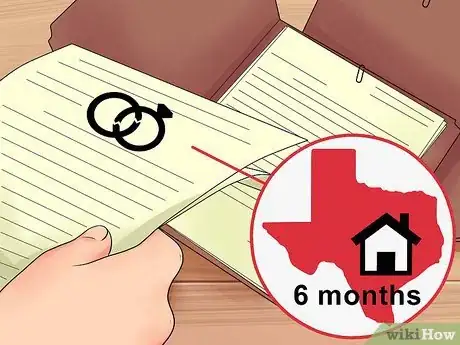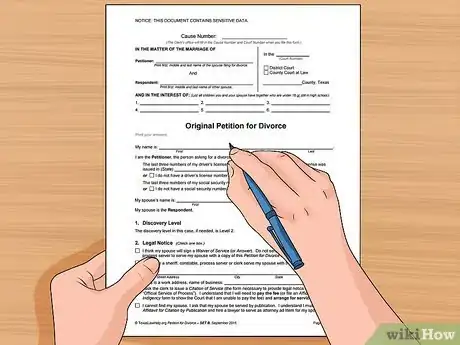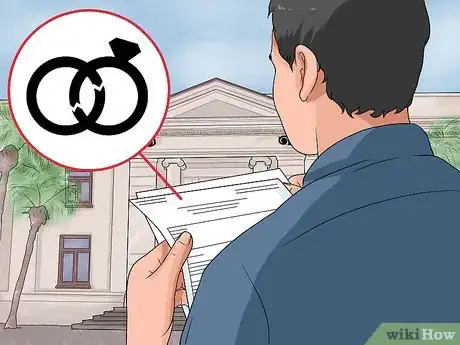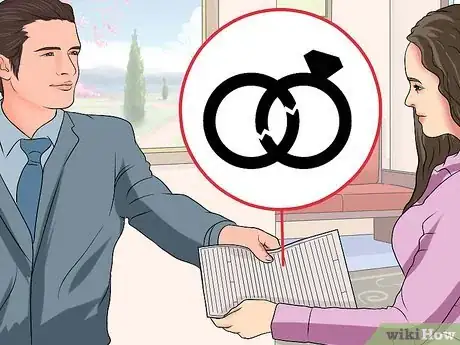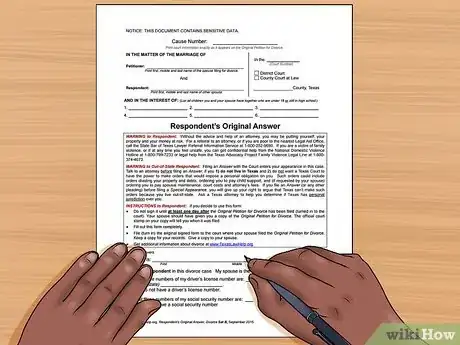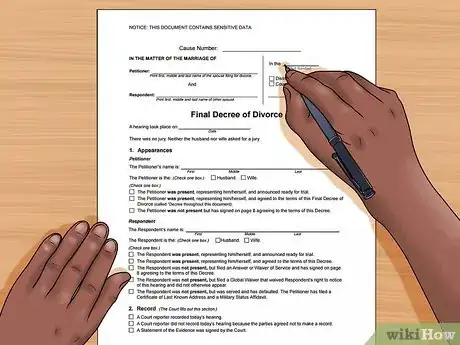This article was co-authored by Clinton M. Sandvick, JD, PhD. Clinton M. Sandvick worked as a civil litigator in California for over 7 years. He received his JD from the University of Wisconsin-Madison in 1998 and his PhD in American History from the University of Oregon in 2013.
There are 9 references cited in this article, which can be found at the bottom of the page.
wikiHow marks an article as reader-approved once it receives enough positive feedback. In this case, 97% of readers who voted found the article helpful, earning it our reader-approved status.
This article has been viewed 241,765 times.
Getting a divorce in Texas is a serious process and results in ending a valid marriage between yourself and your spouse. After making the decision to get a divorce in Texas, you will have to go through a process that involves meeting residency requirements and having a valid ground for divorce, finding an attorney (unless you decide to proceed without one), preparing and filing your divorce petition, and finalizing the divorce. Follow the directions below to ensure you give yourself and your spouse the best opportunity at a successful divorce.
Steps
Making Sure You Qualify For a Divorce in Texas
-
1Meet the residency requirement. At the time you file for divorce, either you or your spouse must have been living in Texas for the preceding six-month period.[1] This does not mean you have to have been married in Texas, but only that you or your spouse has resided in Texas for the required period of time.
- You can still file for divorce in Texas if one of the spouses lives out of state. The requirement only states that one of the spouses has lived in Texas for the required six months.
- If neither you or your spouse has lived in Texas for the required six months, you will be required to get a divorce elsewhere, or wait to get divorced in Texas until you meet the residency requirements.
-
2Have valid grounds for a divorce. In Texas there are seven valid grounds for getting a divorce.[2] If you decide to get a divorce in Texas, you will have to claim one of these reasons for doing so. Each individual reason is discussed below. Insupportability is the only valid ground for divorce that does not place blame on you or your spouse for the divorce.
- Insupportability. This is the only ground for divorce where no fault is placed on you or your spouse.[3] By claiming this reason, you are saying there are differences in the marriage that simply cannot be overcome.[4]
- Cruelty. This exists when you are being treated cruelly and it has gotten to the point that it is no longer feasible to live together given the situation.[5] Examples of cruelty include physical attacks, constant displays of rage, publicly flaunting another relationship, and staying away from the house often without explanation.[6]
- Adultery. Adultery occurs when your spouse cheats on you.[7]
- Conviction of a felony. When your spouse has committed a felony and they have been in prison for one year or more (and have not been pardoned), that constitutes a conviction and becomes a valid ground for divorce.[8] However, this is not a valid ground for divorce if your testimony is what caused your spouse to be convicted of the felony.[9]
- Abandonment. When your spouse has left you for a period of a year or longer and has no intention of coming back, this becomes a valid ground for divorce.[10]
- Living apart. When you and your spouse have been living apart, with no cohabitation, for a period of three years or longer, you can claim this ground when filing for a divorce.[11]
- Confinement in a mental hospital. At the time you file for a divorce, if your spouse has been confined in a mental hospital for at least three years and it appears the mental disorder will not get better, you can claim this ground.[12]
Advertisement -
3Find out what county you need to file your petition in. When you file a petition for divorce, you must do so in a court of law in the county you or your spouse has been a resident of for at least 90 days.[13] This county is where all of your filings, hearings, and other court appearances will take place.
- If you and your spouse have not lived in your county for the required 90 day period, you will be required to wait to file for divorce until one of you meets this requirement.
Understanding the Effects of a Divorce
-
1Think about how your property will be distributed. Texas is a community property state, which means that when you file for and are granted a divorce, your property will generally be split evenly with your spouse.[14]
- This rule is not absolute and there are certainly qualifications, so be sure to read all of the laws regarding community property here. For instance, property will be considered separate, and therefore belong to one spouse alone, if the property was owned or claimed by the spouse before the marriage; if the property was acquired by a spouse by gift, devise, or descent; or if the property was recovered by one spouse as a result of personal injuries sustained by that spouse.[15]
- If there is one reason to have an attorney during a divorce, this may be one of the most important reasons. The laws surrounding community property can be complex and divorce attorneys often have ample experience handling property distribution.
-
2Talk to your spouse about child custody and child support. Upon divorce, or even before, a judge may decide how you and your spouse are going to split custody of your child, if you have one. Also, you and your spouse will have to deal with child support, which is a payment of money to a spouse so that spouse can care for the child.
- For the well being of the child, you and your spouse should do your best to agree on a shared custody plan. Doing so will allow your child to spend time with both parents and you will avoid having a judge intervene on the issue.
- You should also be aware that Texas allows a judge to require one of the spouses to provide child support to the other spouse in certain situations.[16]
- Try to work these issues out before the divorce so you don't have a judge making a decision you may regret.
-
3Know about spousal support. In Texas, spousal support is termed "maintenance."[17] Maintenance is available to a spouse if the spouse asking for support will not have enough property to support her after the divorce is finalized.[18]
- In addition, the spouse asking for maintenance must show that he or she is not able to earn enough money due to a mental or physical disability; has been married for 10 years or more and cannot make enough money to support themselves; or has custody of a child of the marriage who has a mental or physical disability that requires substantial care.[19]
- A spouse may also get maintenance if the other spouse was convicted of a crime of family violence that was committed during the marriage and it occurred two years before the divorce filing or while the divorce was pending.[20]
Finding an Attorney
-
1Decide whether having an attorney is the right choice for you. Hiring an attorney to help you through the divorce process can be advantageous for a number of reasons, but it can also be a burden. Consider these factors in deciding whether hiring an attorney is the right choice for you:
- Foregoing the help of an attorney may be advantageous if you are getting an uncontested divorce where you and your spouse are splitting amicably and will be working out all of the details together. In this situation, an attorney may only hinder your ability to talk honestly and openly with your spouse about all of the issues needing to be resolved. You should also be aware that if you do not have an attorney, you and your spouse will be responsible for drafting and filing all of your legal papers with the court. This task can be time consuming and complex, so be sure you are ready to take it on when you choose to not hire a lawyer.
- If your divorce is likely to be contested, or if you need help drafting and filing legal papers, then you should consider hiring an attorney. Contested divorces often get messy, with at least one spouse fighting over children, property, and/or money. If this sounds like the divorce you might be going through, an attorney can help you craft legal arguments to ensure you get the fairest distribution of assets possible. An attorney will also be helpful when you do not have the time or expertise necessary to draft and file legal documents. Filing for a divorce is a legal matter and will involve a large amount of legal paperwork.
-
2Research possible attorney candidates. If you decide you would like to hire a lawyer, start by researching possible candidates. Follow the steps here to choose the right one.
- First, start by asking friends, family, and coworkers for their referrals. A referral can be a great way to obtain a qualified attorney so long as you trust the opinion of the person giving you that referral. If your peers do not know any divorce attorneys, look online by using lawyers.com, nolo, or findlaw. All of these websites are great for searching out qualified lawyer candidates.
- Second, once you have found a list of candidates, you should contact and set up an initial consultation with them. An initial consultation will help you get a feel for the attorney by meeting him or her in person and being able to ask them questions about themselves and about your case.
-
3Choose an attorney that is right for you. Once you have sat down with your top candidates, you should follow-up with any of them you have more questions for. Once this process is complete and you feel comfortable, choose the attorney that you are most comfortable with. Look for an attorney with a fair fee, a good track record of handling divorce cases, and a good reputation for honesty and integrity.
- If you find out through your research and discussions that hiring an attorney will be too expensive for you, you can try finding an attorney that will take your case on a pro bono basis (taking on the work without charge). Try contacting your local or state bar association for help finding an attorney free of charge. With that said, a lawyer in Texas is not required by law to take on any pro bono work.[21]
Preparing and Filing Your Divorce Petition
-
1Draft your petition for divorce. To start the divorce process, you will have to prepare a petition for divorce. A petition for divorce is a court document asking the court to rule on and finalize your divorce. The petition can be found here. If you have hired an attorney, he or she will help you fill out this petition. The petition asks for the following information:
- What level of discovery you will need. Discovery is a phase before a hearing where you and your spouse can ask each other for documents and interviews that are relevant to the divorce. The types of documents you may ask for include financial records, tax returns, loan applications, and account records.[22]
- Legal notice. This section asks you to check off how you are going to provide legal notice to your spouse.
- Qualifying questions. The petition will ask you to verify that you meet all the requirements necessary in order to have a divorce in Texas.
- Dates of marriage.
- Grounds for divorce.
- Children's information. This section asks a number of questions about children you had with your spouse during the marriage. You will be asked about who has jurisdiction over the child, if the child has any property, if the child has health insurance, who has custody of the child, and who has visitation rights with the child.
- History of violence. You will have to disclose whether there has been any history of violence during the marriage and if that violence is likely to affect the divorce in any way.
- Property questions. Because you will have to distribute the marital property upon divorce, the court will want to know what property you have, who owns it, when it was purchased, and how it will be distributed (if you know).
- A request for judgment. This section specifically asks the court to accept your divorce.
-
2File the divorce petition. Once you have prepared the petition for divorce, you will need to file it with the court in the county that you identified when considering whether you qualify for a divorce in Texas. In order to file the petition, you will need to go to the courthouse, give your petition to the clerk of courts, get it signed, and pay a fee.[23] The filing fee varies from county to county but you can call your courthouse and ask for more information.[24] If you have hired an attorney, he or she will help you file your petition.
-
3Give your spouse the required legal notice. Once you have filed your petition for divorce, you will be required to notify your spouse of the pending divorce. Notifying your spouse requires you to give a copy your petition to your spouse so that he or she can examine it and make an appropriate answer. You can provide the required notice a number of ways:
- If you think your spouse will waive his or her right to notice, you can have them sign a waiver and file that with the petition for divorce.[25]
- If you need to notify your spouse and you can locate them, you can send a sheriff or another qualified person to serve your spouse with the divorce papers.[26] The sheriff or other qualified person will give your spouse the required papers and will have them sign a form stating they were served.
- If you cannot find your spouse, you can notify him or her through publication, which involves publishing your notice of divorce.[27]
-
4Allow your spouse to file an answer or counter petition. Once your spouse has received the required notice, he or she will have an opportunity to answer the claims you made in your petition for divorce. The answer form can be found here. The answer will ask your spouse for the following:
- A denial or acceptance of the divorce petition. Your spouse will have an opportunity to deny any or all of the claims you made in your petition for divorce, or he or she will have the opportunity to accept what was said and finalize the divorce.
- Separate property. Your spouse will have the opportunity to list the property that he or she considers to be separate, and therefore not allocatable upon divorce.
- A prayer. A prayer is another term for a request. This simply asks the court to believe the statements made in the answer and rule in favor of the spouse filing the answer.
- A certificate of service. Once your spouse files this answer, he or she will have to give you or your attorney a copy so you can see it and respond to it.
-
5Determine if your divorce is contested or uncontested. Determining whether your divorce is contested or uncontested is important because it will help you understand how the rest of the process is going to proceed.
- If your spouse agreed with the petition for divorce and signed the notifications you provided him or her, then the divorce will be uncontested.[28] Even if your divorce is uncontested, you will still be required to go through the 60 day waiting period and you will have to go to court to have a judge look over the divorce decree and sign it.[29]
- If your spouse disagreed and contested with some of the things you had in the petition for divorce, you will have to go to court and settle the disputes in front of a judge.
-
6Go through the required waiting period. Once the petition for divorce has been filed, a 60-day waiting period begins before you can finalize your divorce.[30]
- During this 60 day period, there may be negotiations and/or mediations if the divorce is contested.[31] These proceedings will help finalize the details of your divorce before having your hearing. You may even work out your differences during these meetings and transform a contested divorce into an uncontested one.
- There may also be interim court hearings for pressing issues, such as temporary orders for child custody or restraint.[32] If you and your spouse are unable to agree on child custody while the divorce is being processed, a judge may step in before the divorce is finalized if he or she feels they must do so for the well-being of the child. If this is the case, a judge will rule on who will get custody of the child, at least while the divorce is being finalized. Also, if you and your spouse are having trouble getting along, a judge may step in before your divorce hearing and issue a temporary restraining order, which will dictate whether you and your spouse can even have contact with each other during the divorce process.
- If children are involved in the divorce, you and your spouse may also have to go through specific classes discussing divorces and children during this waiting period.[33]
Finalizing Your Divorce
-
1Write a decree of divorce. Whether the divorce is contested or not, the final legal document you will have to prepare and file is the decree of divorce. This document verifies all of the final decisions that were made between you, your spouse, and the court. The decisions include those about property, money, support, and children.
-
2Attend any required pre-divorce classes. During the 60 day waiting period and before you attend the court hearing to get your divorce decree signed, you must complete any parenting classes that are required if you have a child with your spouse. Make sure you do not blow these off as it may delay your divorce and cause the judge to impose other requirements.
-
3Attend your divorce hearing. The final step in ending your marriage is the divorce hearing. If your divorce is uncontested, the judge will simply look over the divorce decree and he or she will sign it if they are satisfied. If the divorce is contested, a judge will hear both sides and decide how to end the marriage, including how to split up property and child custody rights. The judge's decisions will be formalized in the divorce decree and the judge will sign it.
Warnings
- If you are served with divorce papers, you must respond as soon as you can in order to avoid possible adverse judgments or delays.⧼thumbs_response⧽
References
- ↑ https://www.womenslaw.org/laws/tx/divorce
- ↑ https://www.womenslaw.org/laws/tx/divorce
- ↑ https://www.womenslaw.org/laws/tx/divorce
- ↑ https://www.womenslaw.org/laws/tx/divorce
- ↑ https://www.womenslaw.org/laws/tx/divorce
- ↑ https://www.lawyers.com/legal-info/family-law/divorce/grounds-for-divorce-cruelty.html
- ↑ https://www.womenslaw.org/laws/tx/divorce
- ↑ https://www.womenslaw.org/laws/tx/divorce
- ↑ https://www.womenslaw.org/laws/tx/divorce
- ↑ https://www.womenslaw.org/laws/tx/divorce
- ↑ https://www.womenslaw.org/laws/tx/divorce
- ↑ https://www.womenslaw.org/laws/tx/divorce
- ↑ https://www.womenslaw.org/laws/tx/divorce
- ↑ https://www.womenslaw.org/laws/tx/divorce
- ↑ http://www.statutes.legis.state.tx.us/Docs/FA/htm/FA.3.htm
- ↑ https://www.womenslaw.org/laws/tx/divorce
- ↑ https://www.womenslaw.org/laws/tx/divorce
- ↑ https://www.womenslaw.org/laws/tx/divorce
- ↑ https://www.womenslaw.org/laws/tx/divorce
- ↑ https://www.womenslaw.org/laws/tx/divorce
- ↑ https://www.texasbar.com/AM/Template.cfm?Section=About_Us_FAQs
- ↑ http://www.divorcenet.com/states/missouri/mo_art09
- ↑ http://info.legalzoom.com/file-original-petition-divorce-texas-20695.html
- ↑ http://info.legalzoom.com/file-original-petition-divorce-texas-20695.html
- ↑ http://texaslawhelp.org/files/685E99A9-A3EB-6584-CA74-137E0474AE2C/attachments/19431F3C-3493-4F0A-A1EB-255937C02B64/div_w_kids_petition_final.pdf
- ↑ http://texaslawhelp.org/files/685E99A9-A3EB-6584-CA74-137E0474AE2C/attachments/19431F3C-3493-4F0A-A1EB-255937C02B64/div_w_kids_petition_final.pdf
- ↑ http://texaslawhelp.org/files/685E99A9-A3EB-6584-CA74-137E0474AE2C/attachments/19431F3C-3493-4F0A-A1EB-255937C02B64/div_w_kids_petition_final.pdf
- ↑ http://www.depts.ttu.edu/sls/forms/Pro-Se-Divorce-Handbook.pdf
- ↑ http://www.depts.ttu.edu/sls/forms/Pro-Se-Divorce-Handbook.pdf
- ↑ http://www.depts.ttu.edu/sls/forms/Pro-Se-Divorce-Handbook.pdf
- ↑ http://www.depts.ttu.edu/sls/forms/Pro-Se-Divorce-Handbook.pdf
- ↑ http://www.depts.ttu.edu/sls/forms/Pro-Se-Divorce-Handbook.pdf
- ↑ http://www.depts.ttu.edu/sls/forms/Pro-Se-Divorce-Handbook.pdf
- ↑ http://www.parentingchoice.com/aboutus.asp
- ↑ http://www.parentingchoice.com/aboutus.asp
About This Article
To get a divorce in Texas, start by making sure you have valid grounds, like insupportability, adultery, or living apart. Next, decide if you want an attorney, which is helpful if there’s fighting over children, property, or money, but if the divorce is amicable you can file yourself. To start the process, prepare a petition for divorce, which will cover such questions as when you got married, the grounds for divorce, and what property you have. Once you file the petition, there’s a 60 day waiting period before things can be finalized. To learn about required pre-divorce classes, keep reading!
